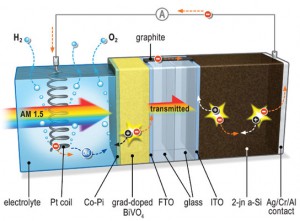
Scientists Achieve Solar Hydrogen Production Breakthrough
A newly published study reveals how scientists used a solar cell and a photo anode made of a metal oxide to achieve a solar hydrogen production breakthrough.
The experts were able to develop a rather elegant and simple system for using sunlight to split water into hydrogen and oxygen.

This process, called artificial photosynthesis, allows solar energy to be stored in the form of hydrogen. The hydrogen can then be used as a fuel either directly or in the form of methane, or it can generate electricity in a fuel cell.
One rough estimate shows the potential inherent in this technology: At a solar performance in Germany of roughly 600 Watts per square meter, 100 square meters of this type of system is theoretically capable of storing 3 kilowatt hours of energy in the form of hydrogen in just one single hour of sunshine. This energy could then be available at night or on cloudy days.



